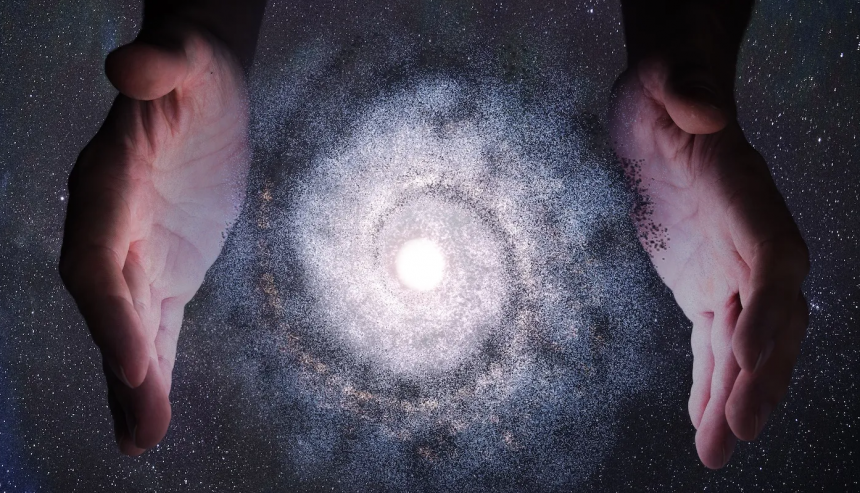The greatest philosophers throughout history have been preoccupied with the profound and ageless dilemma of whether the God of religion and the God of science are the same. The junction of two seemingly opposing ideologies—the spiritual profundity of religion and the factual rigor of science—lays at the core of this argument. But are these routes really as different as they seem? Can the God worshipped via religious devotion coexist with, or even be the same as, the God revealed through scientific inquiry?
Using the knowledge of philosophers, theologians, and scientists who have approached the idea of God from various angles, this article sets out on an intellectual exploration of this perplexing question.
The God of Religion: A Historical Perspective
Religion, in its myriad forms, has long been humanity’s attempt to understand the mysteries of existence. From ancient polytheistic traditions to the monotheistic religions that dominate today’s spiritual landscape, the concept of God has been central to the human experience. In religious contexts, God is often seen as an omnipotent, omniscient, and omnipresent being—a creator who is intimately involved in the world and the lives of its inhabitants.
Religious philosophers such as Thomas Aquinas and Augustine have shaped much of Western thought on the nature of God. Aquinas, in his “Summa Theologica”, posited that God is the “unmoved mover,” the first cause in a chain of causality that leads to the existence of everything in the universe. He argued that God’s existence could be inferred through reason and observation of the natural world, a notion that finds echoes in modern scientific approaches to understanding the universe.
In contrast, Eastern philosophies, such as Hinduism and Buddhism, offer different conceptions of the divine. Hinduism presents a pantheon of gods, with Brahma as the ultimate, formless reality that underlies all existence. Buddhism, while often considered non-theistic, speaks of a transcendental reality that is beyond conventional understanding, often equated with the concept of Nirvana. Despite their differences, these religious traditions share a common theme: the divine is viewed as an essential, guiding force in the universe, transcending human understanding and manifesting in various forms.
The God of Science: The Search for Universal Laws
Science, on the other hand, seeks to understand the universe through observation, experimentation, and the formulation of laws that describe natural phenomena. The God of Science is often thought of not as a personal deity, but as the underlying principles and forces that govern the cosmos. The scientific method, with its emphasis on falsifiability and empirical evidence, appears at first glance to be at odds with the faith-based approach of religion.
However, many of the most influential scientists in history have viewed their work as a way of understanding the divine. Isaac Newton, often considered the father of modern physics, saw his discoveries as revealing the mechanical order of God’s creation. For Newton, the laws of motion and universal gravitation were not just descriptions of how the world works; they were evidence of a divine architect who had designed the cosmos with precision and purpose.
Albert Einstein, too, grappled with the concept of God, famously stating, “I want to know God’s thoughts—the rest are details.” Einstein’s God, however, was not the personal God of religion but rather the God of Spinoza—a pantheistic view where God is synonymous with the universe and its natural laws. Einstein’s search for a unified theory that would explain all physical phenomena was, in a sense, a search for this God.
Stephen Hawking, in his seminal work “A Brief History of Time”, pondered the nature of God in relation to the universe. Hawking suggested that if a complete unified theory were discovered, it would be the ultimate triumph of human reason—”for then we would know the mind of God.” Yet, like Einstein, Hawking’s conception of God was abstract, aligning more with the awe of the unknown than with any traditional religious understanding.
Philosophical Reflections and Devine Equation
The relationship between the God of Science and the God of Religion has been the subject of deep philosophical inquiry. One of the most significant contributions to this discussion comes from Immanuel Kant, who argued that while science and religion address different domains of human experience, they are not necessarily in conflict. In his “Critique of Pure Reason”, Kant proposed that while science deals with the realm of phenomena—what can be observed and measured—religion concerns itself with noumena, the things-in-themselves that lie beyond empirical observation. This idea finds resonance in the concept of non-overlapping magisteria (NOMA) proposed by Stephen Jay Gould, who argued that science and religion each represent distinct domains of teaching authority and should not be seen as competing with one another.
However, not all thinkers agree with this harmonious view. Friedrich Nietzsche famously declared, “God is dead,” reflecting his belief that the traditional religious concept of God had lost its power in the modern, scientifically-oriented world. For Nietzsche, the rise of scientific rationalism had rendered the God of Religion obsolete, and humanity was now faced with the challenge of finding meaning in a godless universe.
In contrast, process theologians such as Alfred North Whitehead and Charles Hartshorne have attempted to reconcile science and religion by proposing a dynamic, evolving concept of God. In process theology, God is not an immutable, omnipotent being but rather a participant in the ongoing creation of the universe, a force that evolves alongside the cosmos. This view aligns more closely with the God of Science, who is intimately connected with the processes and laws that govern the universe.
The Quest for Unity: Toward a Synthesis
In the quest to reconcile the God of Science with the God of Religion, many modern thinkers have proposed a synthesis that draws from both perspectives. One such approach is panentheism, which posits that the universe is a part of God, but that God also transcends the universe. This view allows for a God who is both immanent, present within the natural world in its laws, and transcendent, existing beyond the physical universe.
In the vast expanse of the cosmos, where the fabric of space and time weaves together galaxies, stars, and planets, a silent force governs the motion of all bodies: gravity. This force, though invisible and intangible, is the thread that holds the universe together. It is a force that speaks of order amidst the chaos, of connection amidst the void. At the heart of this force lies a constant, a number that does not change regardless of the size or distance of the objects in question. This is the Universal Gravitational Constant, denoted by the symbol G.
But what is this G? What is its significance in the grand scheme of existence? Why does this ratio—((Force) (distance^2)/(mass of one body)(mass of the second body))—remain constant, regardless of the circumstances? In this mysterious and immutable ratio, one might find a reflection of something far greater than a mere physical law.
G is not just a constant; it is a universal law that governs the interaction of all matter. It is the hidden hand that guides the dance of the planets, the gentle tug that pulls us toward the Earth, the force that binds us to the cosmos. But this force, this constant, is not self-explanatory. It points to something beyond, something that exists outside the confines of our universe, something that cannot be explained by the laws of physics alone.
This G, I propose, is the factor of God—a divine signature imprinted upon the fabric of the universe. It is the controlling factor that ensures that no matter how vast the distance, how massive the bodies, or how insignificant their interaction may seem, the relationship remains consistent. It is as if the universe is a grand symphony, and G is the conductor, ensuring that every note is in harmony, every movement is in sync.
The universe, then, is not a lifeless void, but a living entity, growing and expanding, fed by an outside force—a giant, if you will. This giant is an attribute of God, a being beyond our comprehension, existing in dimensions beyond our scope. Just as we are but a minute part of this vast universe, so too is our understanding but a small glimpse into the nature of this divine force.
Imagine, for a moment, that our universe is but one of many, each nested within another, like Russian dolls. Each universe has its own laws, its own constants, its own controlling factors, all attributes of this giant God. We cannot fully comprehend this being, for it exists outside our universe, beyond the limits of our senses and dimensions. Yet, in the constant G, we catch a glimpse of this being, a hint of the divine order that governs all existence.
In our search for extraterrestrial life, we often imagine aliens as beings with eyes, ears, and limbs like ours. But this is a narrow view, constrained by our own experiences and biology. Even on Earth, different species perceive the world in entirely different ways. A snake, for instance, sees in infrared, experiencing a reality that is entirely alien to us. How much more, then, would a being from another universe perceive reality differently? Perhaps these aliens exist in a spectrum beyond our perception, invisible and unknowable to us, just as the divine giant is beyond our understanding.
In the same way, consider the speed of light, an unyielding constant, unaffected by the motion of its source or observer. No matter the speed at which we travel or the nature of the medium it traverses, light remains steadfast at approximately 299,792, 458 meters per second. This constancy suggests a law beyond the physical—a divine decree that underpins the very structure of space-time. It is as if light itself carries the imprint of an eternal truth, a fingerprint of a God who transcends the fluctuations of the physical world.
In contemplating these equations or constants, we are invited to see the universe not just as a collection of physical laws but as a reflection of something greater. These invariances are the attributes of a God who is both within and beyond our universe—a God who is both the source and sustainer of all that exists including an observer.
God, I believe, has painted us on a three-dimensional canvas of space, using time as the brushstroke. As we move through this canvas, we are bound by the laws of physics, by the constant G, by the flow of time. But what if, one day, we could move faster than light? What if we could step outside this canvas and see the universe from a different perspective? Perhaps then, we would see the future unfold before us, predict the patterns of the cosmos, and understand the divine order that governs all things.
And perhaps, just as a chick emerges from its eggshell after consuming all its nutrients and encounters a vast new universe—surprisingly, without a failure of heart—so too, one day, we may break free from the confines of our universe and encounter the giant—the divine being that exists outside our reality. In that moment, we would see that the universe is but one of many, each connected to the other, each governed by its own laws, each a reflection of the divine.
This is the nature of the universe, a vast and infinite system of interconnected realities; each governed by the divine constant like G, each a part of the grand design of the giant God. It is a design that we may never fully understand in our present existance, but one for sure that we can glimpse in the constant forces that bind us to the cosmos, in the divine equation that governs all existence. And in this glimpse, we find not only the signature of God but also the profound mystery of our own existence, a mystery that calls us to explore, to understand, and to ultimately meet the divine with respect and reverence.
My words seek to bridge the journey where science and faith converge—not as opposites but as two paths leading to the same boundless mystery. One reaches outward to fathom the universe, while the other delves inward to touch the soul; together, they form a whole that hints at truths far beyond us. Thus, I believe my writings invites you to consider the possibility that science and religion, at their core, may be part of the same journey—a journey toward understanding the infinite complexity of existence!
(The Author is Sr. Academic officer (Physics), Department of Education in Science & Mathematics, State Council of Educational Research Training (SCERT), Bemina, Srinagar, E-mail: [email protected])








